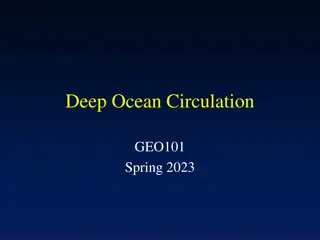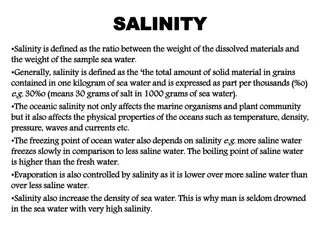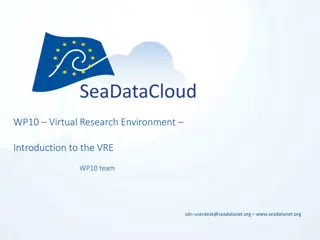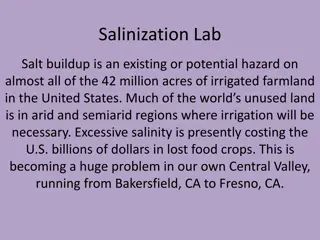Understanding Deep Ocean Circulation and Salinity Patterns
Explore the intricate relationship between ocean salinity, vertical structure, and deep-water currents in this informative collection of images and explanations. Discover how salt inputs and outputs influence ocean salinity levels, and learn about the factors that contribute to the vertical variatio
12 views • 21 slides
Understanding Salinity in Seawater and Its Impacts
Salinity is the ratio of dissolved materials to the weight of seawater, affecting marine life and physical ocean properties like temperature, density, and waves. It influences freezing and boiling points, evaporation, and water density. Seawater composition includes salts like sodium chloride, magne
0 views • 11 slides
Exploring Ocean Water Chemistry: Salinity, Saltiest Body of Water, and Gases
Delve into the complexity of ocean water chemistry, including the significance of salinity levels, the saltiest body of water on Earth at Don Juan Pond in Antarctica, the composition of salts in ocean water, and the role of gases like oxygen and carbon dioxide. Discover how these factors shape the c
0 views • 11 slides
Extreme Environments and Extremophiles: Surviving the Unthinkable
Extremophiles are organisms that thrive in extreme conditions such as high temperatures, acidity, salinity, and more. They have unique adaptations like extremozymes and can withstand harsh environments where life was once deemed impossible. Types include psychrophiles and Firmicutes, showcasing rema
2 views • 24 slides
Correcting Sea Surface Temperature Spurious Effects in Salinity Retrieval
This study focuses on correcting spurious effects in sea surface temperature and salinity retrieval from spaceborne L-band Radiometer measurements. It discusses adjustments of permittivity models and introduces a new parametrization of dielectric constants. Validation using Aquarius data shows promi
1 views • 4 slides
Comprehensive Guide to Irrigation in Agriculture
Irrigation plays a crucial role in agriculture, enhancing crop quality, increasing yields, and driving global food production. This guide covers the benefits, needs, and water quality-related problems associated with irrigation in agriculture, emphasizing its importance in sustaining food supply and
5 views • 14 slides
Exploring Earth's Oceans: From Formation to Technology
Earth's oceans are interconnected bodies of water covering about 70% of the planet. This chapter delves into the formation of oceans, the composition of seawater, the structure of the seafloor, and the technology used to explore the depths. Learn about the theories behind ocean formation, the differ
0 views • 24 slides
Understanding Ocean Salinity and Freezing Points
Explore the world of ocean salinity and freezing points, from the formation of polar ice to the unique characteristics of the Arctic and Antarctica. Discover the composition of ocean water, the concept of salinity, measurement methods, average ocean salinity levels, and how both saltwater and freshw
0 views • 58 slides
Impact of Precipitation on Ocean Salinity: Study at University of Antananarivo
Juliette Soanaoly from the University of Antananarivo presents a study on the impact of precipitation on ocean salinity. The research explores the intercorrelation between rainfall and salinity, variability of precipitation in a specific study area, and the methodologies used to analyze the data ove
1 views • 17 slides
Understanding Atlantic Overturning Observed and Simulated Variability
Exploring the initiation of the Atlantic overturning using observations and simulation reconstructions with models. Analysis of historical agreement, synchronisation, and control simulations. Investigation of a 20-year cycle in sea ice cover, feedback mechanisms, and the impact of events like the Mt
0 views • 32 slides
Understanding Salinity in Seawater: Density, Composition, and Variations
Seawater is denser than freshwater due to dissolved mineral matter, contributing to its salty flavor. Salinity, measured in ppt, indicates the grams of minerals per kg of seawater. The average salinity is 35 ppt, varying between 33-38 ppt. Distillation is essential to purify water by removing dissol
1 views • 31 slides
Introduction to SeaDataClouds Virtual Research Environment
SeaDataClouds Virtual Research Environment (VRE) aims to support versatile use cases in oceanographic research by providing collaborative tools, high-performance data processing, and privacy-respecting configurations. The VRE is designed to facilitate individual and group research projects, combinin
0 views • 22 slides
Impacts of Climate Change on the Caspian Sea Basin
The Caspian Sea Basin is facing numerous consequences of climate change, including temperature and precipitation variations, sea level fluctuations, regional land degradation, changes in sea ice extent, and increased vulnerability to flooding. Various countries in the region are experiencing differe
0 views • 12 slides
Sensitivity of Ocean Sampling for Coupled COAMPS-TC Prediction Study
This study explores the optimal ocean sampling strategy for Hurricane Isaac (2012) using high-resolution in-situ observations. It investigates the sensitivity of tropical cyclone intensity change through assimilation of AXBT, AXCTD, and AXCP observations. Results show significant impact areas along
0 views • 12 slides
Overview of Marine Fungi and Their Habitats
Marine fungi are diverse species that inhabit marine environments, with some being obligate marine fungi while others can adapt to various habitats. They play essential roles in marine ecosystems by decomposing organic matter and interacting with other organisms. Factors affecting their distribution
2 views • 13 slides
Exploring the Hydrological Cycle and Aquatic Environments
Dive into the fascinating world of the hydrosphere with a comprehensive look at the hydrological cycle, water properties, hydrology, salinity, aquatic biomes, and ocean facts. Discover how water moves through Earth's spheres, the distribution of freshwater, the significance of oceans, and their role
0 views • 31 slides
Understanding the Impact of Salinization on Agriculture and Water Resources
Salinization poses a significant threat to agriculture, especially in areas like the Central Valley, leading to lost food crops and economic repercussions. The intrusion of saltwater into aquifers due to excessive irrigation contributes to the problem. Research and lab studies focus on the effects o
0 views • 9 slides
Understanding Water Salinity and Density
Water density is a crucial property influenced by factors like salinity and temperature. Saltwater is denser than freshwater due to dissolved substances, affecting the buoyancy of marine environments. Salinity levels vary in different bodies of water, impacting ecosystems and supporting diverse orga
0 views • 14 slides
Understanding Water Quality Variables and Their Impact on Ecosystems
Water quality variables play a crucial role in natural ecological systems and human water use. Factors like mineral concentrations, toxins, and disease organisms affect the suitability of water for various purposes such as drinking, livestock, irrigation, and industrial use. Density and temperature
0 views • 18 slides
Understanding Extreme Wind Speed Measurements from NASA's SMAP L-Band Radiometer
NASA's SMAP (Soil Moisture Active Passive) mission has been collecting data on extreme wind speeds since April 2015 using an L-band radiometer. The measurements provide valuable insights into wind speed frequencies, with a wide range of signals received by the sensor challenging the data analysis. A
0 views • 17 slides
Understanding NEMO: European Ocean Modeling Software
NEMO (Nucleus for European Modeling of the Ocean) is a comprehensive software used for numerical simulation of the ocean. Its components include the blue ocean (NEMO-OPA) for dynamics, white ocean (NEMO-LIM) for sea-ice simulation, and green ocean (NEMO-TOP) for biogeochemistry. NEMO produces model
0 views • 10 slides
Insights on Ocean Climate Change: Observations and Implications
Observations in this chapter highlight significant changes in ocean properties related to climate over the past 40 years. These changes include shifts in temperature, salinity, sea level, carbon levels, pH, and oxygen content. The patterns of change observed suggest a link between surface and subsur
0 views • 35 slides
Unveiling the Intriguing Properties of Ocean Water
Discover the fascinating characteristics of ocean water, including salinity levels, the saltiest body of water on Earth, the composition of salts, gases present, temperature variations, and changes with depth. Explore how these factors influence marine life and ecosystems.
0 views • 9 slides
Advancing Rice Breeding Partnerships in Myanmar: Current Progress and Future Prospects
The collaborative efforts between IRRI and Myanmar in rice breeding have been fruitful since 1965, with numerous rice varieties released in Myanmar having IRRI lineage. The focus is on developing appropriate rice varieties for different regions to ensure rice yield stability. Target traits for delta
1 views • 17 slides
Challenges and Opportunities in Indian Agriculture
Indian agriculture faces significant challenges, including the need to increase food grain production, decreasing landholdings, resource constraints, and environmental degradation. With a growing population and shifting dietary patterns, there is a higher demand for high-value food commodities. The
0 views • 16 slides
Analysis of CWF.H3+ Scenario Impacts on Delta Salinity
The testimony of Tom Burke presents concerns regarding the significant impacts of the CWF.H3+ scenario on salinity in the south and central delta. Issues such as inaccuracies in the DSM2 model, non-compliance with D-1641 requirements, and changes in water levels and flow patterns are highlighted. Ev
0 views • 31 slides

























